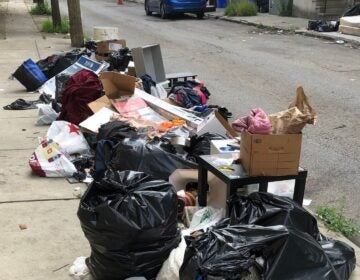On urban food access, don’t forget the voices of youth
We've heard experts, teachers, professors, politicians, and health workers weigh in on food access in Philadelphia, but we shouldn't forget the voices of those most affected.

Kevin Dixon, Tre'Cia Gibson, and Jahzaire Sutton work at Rebel Ventures, a youth-centric business that develops healthy snacks served by the School District of Philadelphia and other venues around the city. (Jarrett Stein for NewsWorks)
In the nation’s poorest big city, food insecurity is rampant, and fresh fruits and vegetables in particular are challenging to acquire in many neighborhoods. We’ve all heard experts, teachers, professors, politicians, and public health workers weigh in about food access in Philadelphia — often providing valuable information and important resources. But we shouldn’t forget about the voices of people most affected by food availability, or lack thereof: the youth who live and work in the neighborhoods in question.
Kevin Dixon, 20, stands at the back of a small convenience store in West Philadelphia next to a shelf holding containers of sliced melon. “This is about the only healthy food you actually see,” says Dixon, who works nearby. “But it’s surrounded by chocolate, Tastykakes. The watermelon costs $3.50. Cake is 50 cents.”
A line of people backs up at the deli as customers wait for hoagies made to order, some grabbing a bag of chips or a soft drink on the way to the checkout. “It’s all about placement,” says Jahzaire Sutton, 16, Dixon’s friend and co-worker. “Here’s the water in the back. It’s $2 for sport water. At the front you can get Canada Dry for 50 cents.”
Dixon, Sutton, and colleague Tre’Cia Gibson, 18, are examining the food environment on a small commercial strip on Spruce Street near the intersection with 48th. The primary sources of food in the neighborhood, they agree, are the small delis and snack outlets they call poppy shops, a name believed to be a nod to their frequent Hispanic ownership — Dixon and Sutton debate whether they should be spelled “poppy” or “papi,” but think the former is more prevalent among their peers.
There are full-sized grocery stores in the vicinity, though not immediately so — a Shop n Bag at 43rd and Walnut, Sav-A-Lot up at 57th and Vine, and Fresh Grocers at 40th and Walnut and 56th and Chestnut — but none so convenient as a corner store where you can buy prepared food and snacks without leaving the block. “It’s how fast you can get your meal versus thinking long-term,” Dixon says. “This is right around the corner. You go ahead and grab it and be out.”
Crucially, most poppy shops accept EBT cards, or food stamps, making them accessible to people in high-poverty neighborhoods who receive government benefits. But the stores don’t encourage healthy eating, particularly for people on a budget. “You can just get some chips for a dollar, or snacks,” Gibson says. “A salad costs more than a cheesesteak platter.”
Outside, a man walks down the street carrying a pizza box and a greasy paper takeout bag. Next door is a small Chinese takeout restaurant, typical of the kind found in neighborhoods throughout Philadelphia. “They do have a diet menu,” Gibson points out. “Steamed vegetables, things like that. But most people don’t look past the chicken fingers or General Tso’s chicken.”
On the other side of the Chinese takeout is another poppy shop, this one offering hot food like cheesesteaks and breakfast sandwiches. There’s no produce whatsoever. Behind the counter are cigarettes, cigars, 5-hour Energy bottles and pain medication. Elsewhere on the block is yet another poppy shop, its shelves nearly empty of goods beyond some snacks and chips, and another Chinese takeout, nearly identical to the first. The strip rounds out with a pizza place and a pair of seafood restaurants.
Around the corner on 48th Street is a dollar store, next to a brewer’s outlet. “This is the closest we get to a bigger retail store here,” Dixon says. Inside is one aisle full of canned goods, another with items like cookies and salad dressing. “Nothing healthy has caught your attention,” he says. Processed food, he notes, lasts virtually forever on the shelf, while produce will go bad if it isn’t purchased quickly, discouraging stores from stocking it.
There is one option for fresh produce on the block. On 48th Street, a man sells fruit and vegetables out of the back of a delivery truck. As the vendor sorts his products, Dixon asks if he promotes healthy eating, or just sells the food. “I just sell,” the man answers. Dixon remarks that the business could be a good opportunity for outreach on nutrition.
Gibson, Dixon, and Sutton all work at Rebel Ventures, a youth-centric business that develops healthy snacks served by the School District of Philadelphia and other venues around the city. Thanks to their jobs, they have more exposure and hands-on experience dealing with food-related issues than many in the community — not to mention the backing of the University of Pennsylvania, which supports the business — but outside of work they want to spread awareness about nutrition and healthy eating to others in Philadelphia who don’t have the same opportunities or interests.
To increase community engagement, Dixon suggests putting fliers up around the neighborhood to remind people about healthy eating. Sutton wonders if efforts can follow examples of pet shelters or “feed the children” campaigns that solicit donations with an emotional appeal. “You need a way to grasp people on an emotional level to increase the amount of attention on unhealthy food in the community,” he says.
As teenagers and young adults, they have limited agency to affect the food system at large, but they contemplate the ability to promote change in the neighborhood. Dixon says he would redesign poppy shops to offer more nutritious fare than the usual greasy, salty snacks. “Nothing but healthy food,” he says. “Something really good for you to eat.”
Gibson agrees, and adds that she would make sure to keep prices low as well. “You have to be on a budget,” she says. “People interested in healthy food might not be able to afford it. You might buy something that’s not so healthy but make it last.”
Sutton says if he had the power, he would dig into the root of the problem and address poverty overall in the neighborhood. “Poverty causes a chain reaction to everything,” he says. “Financial stability ties into affordability ties into what we eat.”
“If you reduce poverty,” he says, “a lot of communities would be a lot better off.”
—
Aaron Kase has written for Philly Weekly, Philadelphia Citizen, Hidden City, Penn Gazette, VICE, BBC Travel, Guardian Travel, Salon, Narrative.ly and other venues.
WHYY is your source for fact-based, in-depth journalism and information. As a nonprofit organization, we rely on financial support from readers like you. Please give today.




